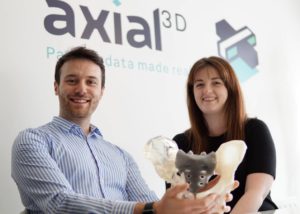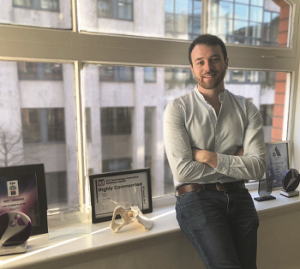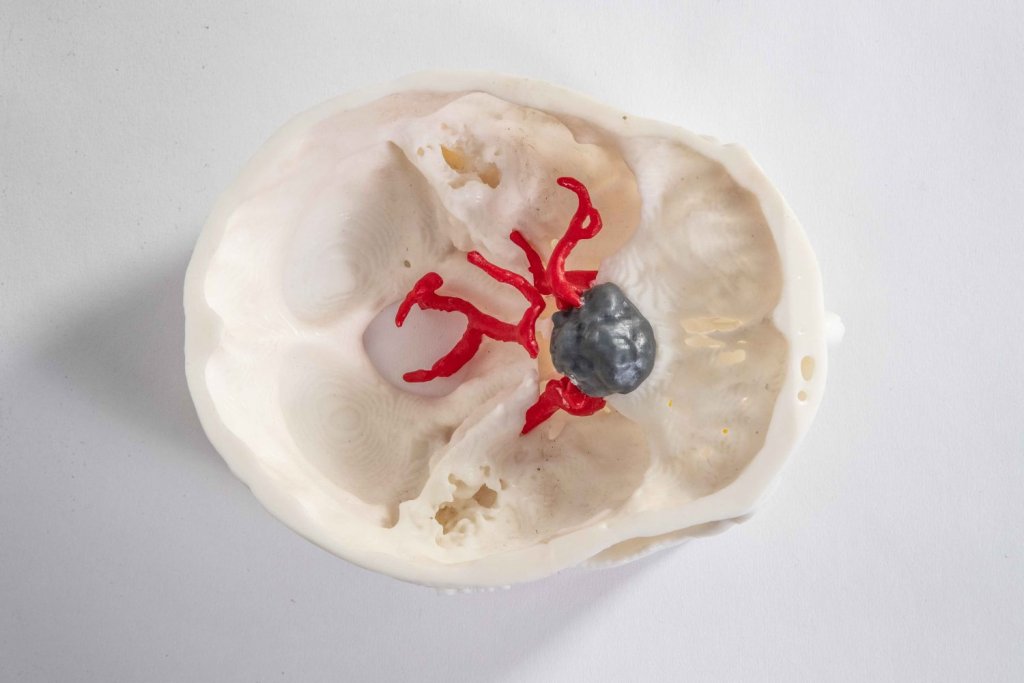 Current 3D printing technologies are helping surgeons and patients achieve more predictable surgical planning, diminish operating time, reduce costs, and especially when it comes to complex anatomies and procedures, the technology can achieve real results. Belfast medical startup axial3D is playing an important role in understanding what is going to be done to the patient by printing precise anatomical models using data generated from CT, MRI and PET scans for healthcare professionals, enhancing insights into pathologies and providing doctors with 3D printed patient-specific models to support physical simulations of surgical procedures. According to the company, this means that, on average, patients will save between 30 and 60 minutes of surgery time (with some cases showing five or more hours saved), and surgical teams increasing their confidence having been able to train and practice using replicas of complex pathological conditions.
Current 3D printing technologies are helping surgeons and patients achieve more predictable surgical planning, diminish operating time, reduce costs, and especially when it comes to complex anatomies and procedures, the technology can achieve real results. Belfast medical startup axial3D is playing an important role in understanding what is going to be done to the patient by printing precise anatomical models using data generated from CT, MRI and PET scans for healthcare professionals, enhancing insights into pathologies and providing doctors with 3D printed patient-specific models to support physical simulations of surgical procedures. According to the company, this means that, on average, patients will save between 30 and 60 minutes of surgery time (with some cases showing five or more hours saved), and surgical teams increasing their confidence having been able to train and practice using replicas of complex pathological conditions.
Founded by Daniel Crawford in 2014, it has been over four years since the company first came on the 3D printing scene, and during this time its customer base began to grow, rising through the ranks of its competitors in Europe and opening the possibilities to support an expansion into new markets, including new offices in the US and more employees. In order to get there, they recently raised $3 million (€2.7 million) in funding.
Led by London-based Imprimatur Capital Fund Management into a Series A round, along with participation from a US investment consortium consisting of surgical angel investors, as well as existing investors Techstart Ventures, and other company supporters, including Clarendon Fund Managers and Innovation Ulster, the investment will support axial3D’s rapid growth plans for the US, including plans to open an office in the region, as well as creating roles within the expanding market and at its Northern Ireland base to support the large growth and to ensure continuous innovation.
“The closure of this investment round marks an important milestone for our company,” said Crawford, Chief Executive of axial3D. “It will accelerate our growth within our expanding markets and enable us to bring our 3D printing solution to more healthcare organizations, helping them to drive down costs, improve compliance and ultimately, enhance patient care.”
The firm makes surgical planning easier thanks to its anatomical models and has wide collaborations with medical professionals, institutions and research hospitals, like The Royal London Hospital, Tallahassee Memorial Healthcare (TMH) and University Hospital Basel. At Newcastle upon Tyne Hospitals NHS Foundation Trust, spinal surgeon Andrew Bowey benefited from one of axial3D’s models to save two hours during surgery on a neural tube defect in the form of Spina Bifida, a very complex procedure. Axial3D usually manages to process and deliver a request within 48 hours, which is of great help to surgeons allowing their clinical teams to counsel the patient and their family, as well as ensuring the surgery is planned accordingly, reducing theatre time and blood loss. The startup had previously raised $650,000 (€478,000) in funding and was also named Emerging Medtech Company of the Year in 2018 at the Irish Medtech Excellence Awards.
Set to grow by more than 23 percent in the next five years, the global 3D printing medical devices market is becoming increasingly adopted within the medical sector.
“Continuous innovation is crucial to bring the best solutions to market and keep up with customer demand. Following our recent collaborations with TMH and University Hospital Basel, we will focus further on the North American and European markets. This includes opening an office in the US, and recruiting more talent into our team, particularly to grow our machine learning capability enabling us to find new ways to bring 3D printing on-demand to the entire healthcare sector,” claimed Crawford.
Neurosurgeon and Charmain of the Board at TMH, Christopher Rumana has been a user of axial3D’s medical 3D printing service since 2018 and is part of the cohort that is now investing in the company. He believes that “axial3D has built a scalable, accessible platform for clinicians to access 3D printing without the capital expenditure or manpower traditionally required.”
“Having been in the medical field for over two decades, I have seen how technology improves patient care. With TMH being a user of axial3D’s service, our own patients have been positively impacted by the use of 3D printing. I want to see this service adopted in more healthcare institutions across the US so that everyone who needs it can benefit from the technology,” suggested Rumana.
 The firm provides a unique Online Ordering Portal to securely upload scans in minutes, then, the team of experts use 3D printing systems to create physical models of the patient’s anatomy and deliver it directly to the consultant, who can even use these anatomical models to better communicate with their patient and show how their medical condition will benefit from a surgical procedure. As opposed to medical imaging, which uses 2D or 3D onscreen technologies, 3D printed models facilitate a better understanding of abnormalities, encourage novel surgical techniques and improve the surgical outcome for patients, therefore eliminating the limitations that radiologists and surgeons encounter while visualizing complex pathologies and abnormalities.
The firm provides a unique Online Ordering Portal to securely upload scans in minutes, then, the team of experts use 3D printing systems to create physical models of the patient’s anatomy and deliver it directly to the consultant, who can even use these anatomical models to better communicate with their patient and show how their medical condition will benefit from a surgical procedure. As opposed to medical imaging, which uses 2D or 3D onscreen technologies, 3D printed models facilitate a better understanding of abnormalities, encourage novel surgical techniques and improve the surgical outcome for patients, therefore eliminating the limitations that radiologists and surgeons encounter while visualizing complex pathologies and abnormalities.
The bespoke models help to personalize healthcare and make 3D printing accessible to the medical community, even providing a powerful aid to surgical education by giving medical students and junior doctors the opportunity to exactly see tumors, fractures, lesions, and other healthcare concerns, that would otherwise be extremely difficult to train with. axial3D is quickly expanding to provide models to even more specialists, encouraging them to try a free patient-specific 3D printed model of their next case providing insights beyond traditional medical imaging and getting doctors enthused about what the technology can offer them, so that we can reimagine the way medical procedures could be like in the future, for everyone.
[Images: axial3D]Subscribe to Our Email Newsletter
Stay up-to-date on all the latest news from the 3D printing industry and receive information and offers from third party vendors.
You May Also Like
Further Understanding of 3D Printing Design at ADDITIV Design World
ADDITIV is back once again! This time, the virtual platform for additive manufacturing will be holding the first-ever edition of ADDITIV Design World on May 23rd from 9:00 AM –...
3D Printer Maker EVO-tech Reborn as NEVO3D — Once More With Feeling
EVO-tech was a 3D printing service and original equipment manufacturer established in 2013 and based in Schörfling am Attersee, Austria. The company produced high-quality material extrusion systems featuring linear bearings,...
3D Systems Brings 3D Printed PEEK Cranial Implant to the U.S. with FDA Clearance
For more than 10 years, 3D Systems (NYSE:DDD) has worked hand-in-hand with surgeons to plan over 150,000 patient-specific cases, and develop more than two million instruments and implants from its...
CDFAM Returns to Berlin for Second Annual Symposium
The second CDFAM Computational Design Symposium is scheduled for May 7-8, 2024, in Berlin, and will convene leading experts in computational design across all scales. Building upon the first event...

































